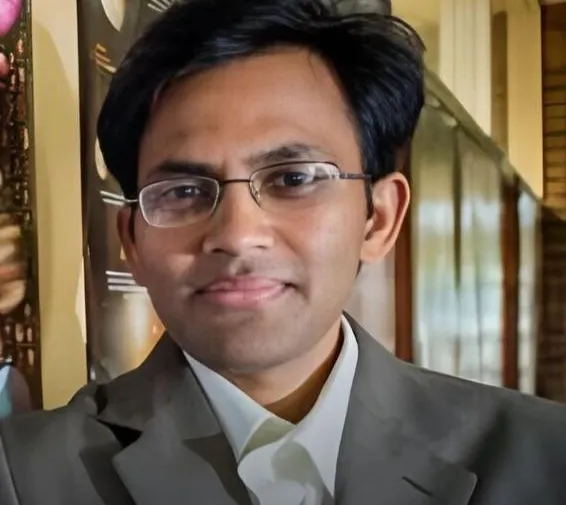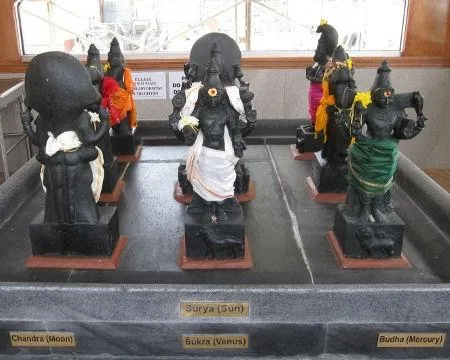Will finding life in other worlds really be new?
Insights from Hindu mythology and modern science

Professor Nikku Madhusudhan
Image: Supplied
A WOMAN with an oil-filled clay lamp in her hand gingerly circumambulates small granite idols at a Chatsworth temple nine times, all the while reciting sacred verses dedicated to each of nine planets.
She is performing "bad luck prayers" to seek intervention from higher forces she believes dwells in these planets, either to break curses, remove evil spirits, or overcome perceived negative influences that are perceived to be causing misfortune. Ultimately, these prayers are aimed to restore blessings and bring about positive change in the devotee’s life.
Ostensibly, this simple act of devotion and seeking divine blessings can be linked to the shrieks of delight emanating from a laboratory at the Institute of Astronomy at the University of Cambridge in the United Kingdom.
Scientists using data from the James Webb Space Telescope, have made an astounding discovery. They believe extraterrestrial life may be thriving beyond our solar system. And which means that interstellar movies such as Alien, ET and Close Encounters of the Third Kind may not be pure fiction after all. There could be life on other distant planets.
Observations of a planet called K2-18b, and which is 124 light years from Earth, appear to reveal the chemical fingerprints of two compounds that, on Earth, are only known to be produced by life. While this would not amount to proof of alien biological activity, it could bring us closer to an answer to the question of whether we are alone in the universe or have cosmic cousins on other planets.
Indian civilisation has been a repository of knowledge since Vedic times, involving subjects such as mathematics, medicine, metaphysics and astronomy, all written in Sanskrit. These ancient learnings are being repackaged several thousand years later and are being presented as discoveries by Western scientists.

Idols of Navagrahas at a temple.
Image: Supplied
According to Hindu mythology, there are billions of universes, and each of those universes has again, millions and billions of galaxies and planets, which include habitable areas too.
My learned Hindu friend Ram Maharaj recounted to me that according to the Vedas, life exists everywhere in creation. Ram bhaiya told me that the ancient Hindu text Yoga Vasishta elaborately mentioned that this earth was but like a speck of dust - or drop in the ocean - in this vast universe and millions of planets are out there, inhabited by living entities.
Thus, the revelation by astrophysicists at Cambridge, led by India-born Professor Nikku Madhusudhan, that their discovery is the strongest evidence to date of some kind of life beyond the solar system, will appear to be old hat to those who have studied ancient Hindu scriptures such as the Bhagavad Gita that embrace the concept of multiple planetary systems and worlds.
These other realms are believed to be inhabited by diverse entities such as demigods, sages, Pitas (ancestors), Gandharvas (celestial musicians), Nagas (serpent beings), Kinnaras (half-human, half-bird beings), and Apsaras (celestial nymphs).
Hindu temple worship is a deeply spiritual experience, connecting devotees to cosmic energies and divine blessings. Hindu philosophy considers human life deeply intertwined with cosmic forces.
The woman at the Chatsworth temple was worshipping the Navagrahas or nine celestial bodies, revered as deities residing in nine planets and impacting earthly life. In Hinduism, these deities dwelling in the celestial Heavens are called Devas and are much like angels that influence and protect creation. They are believed to play a crucial role in shaping our lives. Other faiths also believe in angels.
Muslims believe that angels were created by God before humans and are tasked with carrying out God's orders and communicating messages to humans. They protect and guide believers.
In Christian belief, angels are spiritual beings sent to serve God's will and communicate with humans, often delivering messages or offering protection. Many Christians believe that individuals have guardian angels who watch over them and protect them. Older readers may recall that long before the dash cam (dashboard video camera) came into vogue, a medallion featuring Saint Christopher, the patron saint and protector of travellers, had pride of place on many car dashboards.
The Cambridge astrophysicists have identified possible traces of the molecules dimethyl sulfide (DMS) and/or dimethyl disulfide (DMDS) in the atmosphere of planet K2-18b. This planet orbits within the region around a star where the conditions could potentially be suitable to sustain life, for example allowing the presence of liquid water on the planet’s surface. And it is generally true that where there is water, there is life.
Are we close to really finding alien life? We are not far away, according to Prof Madhusudhan.
"This is basically as big as it gets in terms of fundamental questions, and we may be on the verge of answering that question," he said.
Never before have scientists searched so hard for life on other worlds. And never before have they had such incredible tools with which to do this. Nasa's James Webb Space Telescope, which detected the gas on K2-18b in the discovery by the Cambridge boffins, is the most powerful space telescope ever built. And most expensive - it cost a whopping 10 billion USD.
Prof Madhusudan hopes to have enough data within two years to demonstrate categorically that he really has discovered biosignatures around K2-18b. Biosignatures are indicators or evidence of life.
And many working in the field believe that it is a matter of when, rather than if, they discover life on other worlds. And rather than bringing fear, the discovery of alien life will bring hope, according to Prof Madhusudhan.
Centuries ago, we believed we were at the centre of the universe. But with each discovery in astronomy, we have found ourselves more displaced from that focal point. The discovery of life elsewhere would further reduce our specialness and would be the latest chapter in the diminution of humanity's place in the cosmos.
In the event that life is discovered on other planets with beings advanced enough to resemble human beings, our differences could be fascinating. Would our brethren in space have similar physical traits?
Beyond physical differences, cultural diversity would be mind-blowing. The way we interpret the universe is heavily shaped by Earth - our biology, history, and environment.
Beings from other worlds could be shaped in ways that are incomprehensible to us. They may not have different skin colour. What food will they be eating? What will be their values, communication styles, and perspectives on art, technology, and existence? Would they believe in a Higher Being? A Maker? Gods? Heaven? Hell? As much as we have been looking for them, would they have been searching for us?
If we know there is life elsewhere in our solar system and potentially beyond, we should not feel threatened. It should actually be comforting to know that we earthlings are part of a much larger fabric. And this should make us feel bigger.
No more would we look into the night sky and see just physical objects, stars and planets. We would know there is life out there. Humanity’s understanding of its place in the cosmos would have been redefined. And it could well be time to perform “good luck prayers”.

Yogin Devan
Image: Supplied
Yogin Devan is a media consultant and social commentator. Share your comments with him on: [email protected]
** The views expressed do not necessarily reflect the views of IOL or Independent Media.
Related Topics: